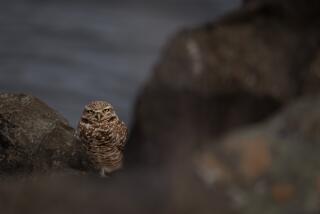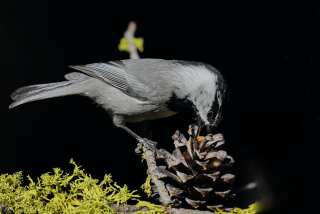Prehistoric feathers found frozen in amber
A trove of prehistoric feathers both primitive and complex is providing scientists with a snapshot of the diversity of down-covered dinosaurs and birds during the late Cretaceous.
An account published in Friday’s edition of the journal Science describes a host of feathers and feather-like filaments found ensconced in 70-million-year-old amber from western Canada. The structures reveal what the precursors of modern feathers really looked like.
“The simplest feathers are of greatest interest because these protofeathers have been inferred to be the evolutionary precedent to evolved feathers,” said study coauthor Alexander Wolfe, a paleoecologist at the University of Alberta in Canada.
Study leader Ryan McKellar, a paleontologist at the University of Alberta, had been examining insects trapped in amber when he came across the strange samples.
Unlike mammalian hairs, the primitive strands were hollow, segmented and lacked scales. They could not have been plant matter because they showed no sign of having cell walls.
After going through about 4,000 amber samples, the team turned up 11 preserved feathers — from simple strands to dense quills — representing a menagerie of prehistoric plumed creatures.
The scientists think the feathers were trapped in sap as animals rubbed against trees growing around what was essentially a shallow ocean, Wolfe said. At that time, he added, Grassy Lake in Alberta was “kind of like the Florida Everglades.”
The collection was far more varied than feather samples from about 90 million years ago, said Mark Norell, chairman of the division of paleontology at the American Museum of Natural History in New York City, who was not involved in the study.
“We never thought we’d have fossils to show all these feathers, from primitive stage-one [protofeathers] to feathers of modern aspect,” he said.
Scientists have posited that feathers developed first as single, hair-like protrusions meant for insulation. Then they began to grow in clumps before evolving into increasingly complex structures, each branching off from a central shaft. They were probably used for other purposes, such as attracting mates, before becoming essential for flight.
Many of the samples described in the study accurately match one of those stages. Some primitive-type feathers closely resemble the fuzz thought to have covered a dinosaur called Sinosauropteryx prima, while others resembled the presumably downy coat of Sinornithosaurus millenii.
Some feathers even had coiled barbules similar to those found on some modern birds. Such barbules allow the sandgrouse to transport water to the nest to cool incubating eggs, and help the grebe dive into water.
“We’re fortunate to have such faithful snapshots preserved in the amber records,” Wolfe said.







